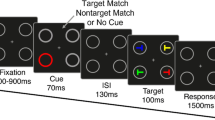Abstract
The Simon effect, an acceleration of responses at the same side that a stimulus is presented, is assumed to be the consequence of an automatic response activation evoked by the processing of the irrelevant stimulus location. This activation has been reported to decline as responses become slower. Consequently, the Simon effect decays over time. However, it remains unclear when this activation starts and what process initiates it. Up to now, the decaying hypothesis and its temporal properties have been based on indirect evidence. In the present study we tested the timing of the decay of the Simon effect more directly by combining a localisation task and a Simon task in an EEG study. It can be shown that the response activation is evoked by visual spatial processing, and that the size of the Simon effect steadily decreases as a function of the time between this localisation process and the manual response. However, this finding only holds if the encoding of relevant stimulus features follows the localisation process unequivocally.





Similar content being viewed by others
References
Coles MGH (1989) Modern mind-brain reading: psychophysiology, physiology, and cognition. Psychophysiology 26:251–269
Coles MGH, Gratton G, Bashore TR, Eriksen CW, Donchin E (1985) A psychophysiological investigation of the continuous flow model of human information processing. J Exp Psychol Human 11:529–553
De Jong R, Liang C-C, Lauber E (1994) Conditional and unconditional automaticity: a dual-process model of effects of spatial stimulus-response correspondence. J Exp Psychol Human 20:731–750
Eimer M, Hommel B, Prinz W (1995) S-R compatibility and response selection. Acta Psychol 90(1–3):301–313
Eriksen BA, Eriksen CW (1974) Effects of noise letters upon the identification of a target letter in a nonsearch task. Percept Psychophys 16:143–149
Fitts PM, Seeger CM (1953) S-R compatibility: spatial characteristics of stimulus and response codes. J Exp Psychol 46:199–210
Gilchrist ID, Humphreys GW, Riddoch MJ (1997) Luminance and edge information in grouping: A study using visual search. J Exp Psychol Human 23:464–480
Gratton G, Coles MGH, Sirevaag EJ, Eriksen CW, Donchin E (1988) Pre- and poststimulus activation of response channels: a psychophysiological analysis. J Exp Psychol Human 14:331–344
Gratton G, Corballis PM, Jain S (1997) Hemispheric organization of visual memories. J Cognitive Neurosci 9:92–104
Hedge A, Marsh NWA (1975) The effect of irrelevant spatial correspondence on two-choice response-time. Acta Psychologica 39:427–439
Hommel B (1993) The relationsship between stimulus processing and response selection in the Simon task: evidence for a temporal overlap. Psychol Res 55:280–290
Hommel B (1994a) Effects of irrelevant spatial S-R compatibility depend on stimulus complexity. Psychol Res 56:179–184
Hommel B (1994b) Spontaneous decay of response-code activation. Psychol Res–Psych Fo 56:261–268
Kim M-S, Cave KR (2001). Perceptual grouping vis spatial selection in a focused-attention task. Vision Res 41:611–624
Kornblum S, Hasbroucq T, Osman A (1990) Dimensional overlap: cognitive basis for stimulus-response compatibility—a model and taxonomy. Psychol Rev 97:253–270
Luck SJ, Hillyard SA (1994a) Electrophysiological correlates of feature analysis during visual search. Psychophysiology 31:291–308
Luck SJ, Hillyard SA (1994b) Spatial filtering during visual search: evidence from human electrophysiology. J Exp Psychol Human 20:1000–1014
Mangun GR, Hillyard SA (1991) Modulations of sensory evoked brain potentials indicate changes in perceptual processing during visual-spatial priming. J Exp Psychol Human 17:1057–1074
Pivik RT, Broughton RJ, Coppola R, Davidson RJ, Fox N, Nuwer MR (1993) Guidelines for the recording and quantitative analysis of electroencephalographic activity in research contexts. Psychophysiology 30:547–558
Prinz W (1990) A common coding approach to perception and action. In: Neumann O, Prinz W (eds) Relationships between perception and action. Springer, Berlin Heidelberg New York, pp 167–201
Proctor RW, Lu C-H (1994) Referential coding and attention-shifting accounts for the Simon effect. Psychol Res 56:185–195
Simon JR, Rudell AP (1967) Auditory S-R compatibility: the effect of an irrelevant cue on information processing. J Appl Psychol 51:300–304
Theeuwes J (1996) Parallel search for a conjunction of color and orientation: the effect of spatial proximity. Acta Psychol 94:291–307
Umiltà C, Nicoletti R (1990) Spatial stimulus-response compatibility. In: Proctor RW, Reeve TG (eds.) Stimulus-response compatibility. Elsevier, Amsterdam, pp 89–116
Van der Lubbe RHJ, Jaskowski P, Wauschkuhn B, Verleger R (2001) Influence of time pressure in a simple response task, a choice-by-location task, and the Simon task. J Psychophysiol 15(4):241–255
Wascher E, Wauschkuhn B (1996) The interaction of stimulus- and response-related processes measured by event-related lateralizations of the EEG. Electroen Clin Neuro 99:149–162
Wascher E, Verleger R, Wauschkuhn B (1996) In pursuit of the Simon effect: the effect of S-R compatibility investigated by event-related potentials. J Psychophysiol 10:336–346
Wascher E, Schatz U, Kuder T, Verleger R (2001) Validity and boundary conditions of automatic response activation in the Simon task. J Exp Psychol Human 27:731–751
Wauschkuhn B, Wascher E, Verleger R (1997) Lateralized cortical activity due to preparation of saccades and finger movements: a comparative study. Electroen Clin Neuro 102:114–124
Wiegand K, Wascher E (in press) Dynamic aspects of stimulus-response correspondence: evidence for two mechanisms involved in the Simon effect? J Exp Psychol Hum Percept Perform
Wolber M, Wascher E (2003) Visual search strategies are indexed by event-related lateralizations of the EEG. Biol Psychol 63:79–100
Wolber M, Wascher E (in press) The posterior contralateral negativity as a temporal indicator of visuo-spatial processing (submitted)
Author information
Authors and Affiliations
Corresponding author
Additional information
This study was supported by grants from the Deutsche Forschungsgemeinschaft to Edmund Wascher (Wa987/6; Wa987/7). The author thanks Meike Reinhard for running the experiments.
Rights and permissions
About this article
Cite this article
Wascher, E. The timing of stimulus localisation and the Simon effect: an ERP study. Exp Brain Res 163, 430–439 (2005). https://doi.org/10.1007/s00221-004-2198-1
Received:
Accepted:
Published:
Issue Date:
DOI: https://doi.org/10.1007/s00221-004-2198-1




